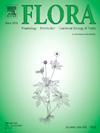Solanum sanctae-catharinae Dunal, a new study of the morpho-anatomy and micromorphology of the leaf and stem
IF 1.8
4区 生物学
Q3 ECOLOGY
引用次数: 0
Abstract
The genus Solanum is considered cosmopolitan due to its worldwide distribution. The species Solanum sanctae-catharinae Dunal (“joá-manso”, “canema”) is a native species which is found in the south and southeast regions of the Brazilian Atlantic Forest. This study aimed to describe leaf and stem morpho-anatomy of the species and determine its morphological singularities, and to identify qualitatively the metabolites of S. sanctae-catharinae through histochemical tests. Field Emission Scanning Electron Microscopy (FESEM) and Energy-Dispersive X-Ray Spectroscopy (EDS) were used to analyze the micromorphology and composition of crystals. Findings in this species, such as hypostomatic leaf and anomocytic stomata, striate cuticle, dorsiventral mesophyll, bicolateral vascular bundle, stellate trichomes in the leaf and stem are reported. With regard to sand crystals in all the structures analyzed, a platy aggregate and magnesium crystals are detected in the petiole. The presence of starch grains, lipid substances and lignin, were reported. These relevant characteristics help in the identification of S. sanctae-catharinae. These were compared with several species of the genus to highlight the main similarities and differences between them.
龙葵(Solanum sanctakaarinae Dunal),叶片和茎的形态解剖学和显微形态学的新研究
茄属被认为是世界性的,因为它分布在世界各地。物种Solanum sancdae -catharinae Dunal (" joá-manso ", " canema ")是巴西大西洋森林南部和东南部地区的本地物种。本研究旨在描述该物种的叶和茎形态解剖结构,确定其形态独特性,并通过组织化学检测定性鉴定其代谢产物。利用场发射扫描电镜(FESEM)和能量色散x射线能谱(EDS)分析了晶体的微观形貌和组成。在叶和茎中发现了低气孔和不规则气孔、条纹角质层、背腹叶肉、双侧维管束、星状毛状体等特征。在所分析的所有结构中,在叶柄中检测到板状聚集体和镁晶体。报道了淀粉颗粒、脂质物质和木质素的存在。这些相关特征有助于对山葵的鉴别。将它们与该属的几个物种进行比较,以突出它们之间的主要异同点。
本文章由计算机程序翻译,如有差异,请以英文原文为准。
求助全文
约1分钟内获得全文
求助全文
来源期刊

Flora
生物-植物科学
CiteScore
3.30
自引率
10.50%
发文量
130
审稿时长
54 days
期刊介绍:
FLORA publishes original contributions and review articles on plant structure (morphology and anatomy), plant distribution (incl. phylogeography) and plant functional ecology (ecophysiology, population ecology and population genetics, organismic interactions, community ecology, ecosystem ecology). Manuscripts (both original and review articles) on a single topic can be compiled in Special Issues, for which suggestions are welcome.
FLORA, the scientific botanical journal with the longest uninterrupted publication sequence (since 1818), considers manuscripts in the above areas which appeal a broad scientific and international readership. Manuscripts focused on floristics and vegetation science will only be considered if they exceed the pure descriptive approach and have relevance for interpreting plant morphology, distribution or ecology. Manuscripts whose content is restricted to purely systematic and nomenclature matters, to geobotanical aspects of only local interest, to pure applications in agri-, horti- or silviculture and pharmacology, and experimental studies dealing exclusively with investigations at the cellular and subcellular level will not be accepted. Manuscripts dealing with comparative and evolutionary aspects of morphology, anatomy and development are welcome.
 求助内容:
求助内容: 应助结果提醒方式:
应助结果提醒方式:


